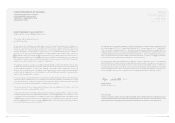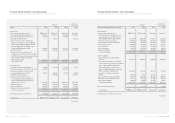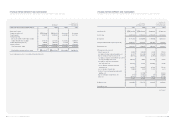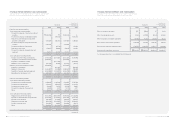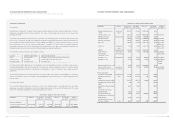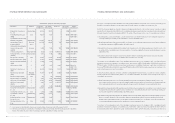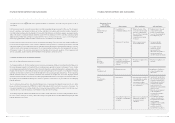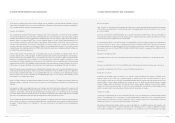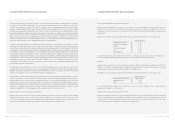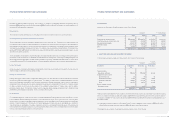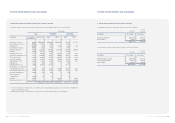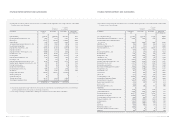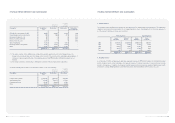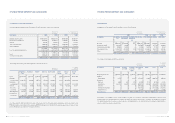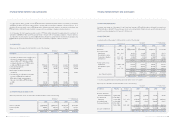Hyundai 2003 Annual Report Download - page 35
Download and view the complete annual report
Please find page 35 of the 2003 Hyundai annual report below. You can navigate through the pages in the report by either clicking on the pages listed below, or by using the keyword search tool below to find specific information within the annual report.
Hyundai Motor Company Annual Report 2003 _6867_Hyundai Motor Company Annual Report 2003
HYUNDAI MOTOR COMPANY AND SUBSIDIARIES HYUNDAI MOTOR COMPANY AND SUBSIDIARIES
The Company’s accounting policies have not been changed since the preparation of the 2002 financial statements, except for
changes due to the application of the above SKAS. The significant accounting policies followed by the Company in the preparation
of its consolidated financial statements are summarized below.
Principles of Consolidation
The consolidated financial statements include the individual accounts of the Company and its domestic and foreign subsidiaries
over which the Company has control, is the largest shareholder and owns more than 30 percent of the voting shares, except for
companies with total assets of less than 7,000 million ($5,844 thousand) at the end of the preceding fiscal year. Investments in
affiliates in which a consolidated entity is able to exercise significant influence over the operating and financial policies of a
non-consolidated company are accounted for using the equity method. Significant influence is deemed to exist when the investor
owns more than twenty percent of the investee’s voting shares unless there is evidence to the contrary. If the changes in the
investment value due to the changes in the net assets of affiliates, whose individual beginning balance of total assets or paid-in
capital at the date of its establishment is less than 7,000 million ($5,844 thousand), are not material, investments in affiliates can
be excluded from using the equity method.
The investment account of the Company and corresponding equity accounts of subsidiaries are eliminated at the dates the
Company obtained control over the subsidiaries. The difference between the investment cost and the fair value of the Company’s
portion of assets acquired less liabilities assumed of a subsidiary is accounted for as goodwill or negative goodwill. Goodwill is
amortized on a straight-line basis over its useful life, not exceeding twenty years. The amount of negative goodwill not exceeding
the total fair value of acquired identifiable non-monetary assets is recognized as income on a straight-line basis over the remaining
weighted average useful life of the identifiable acquired depreciable assets and the amount of negative goodwill in excess of the
total fair value of the acquired identifiable non-monetary assets is recognized as non-operating gain at the date of acquisition.
When the Company acquires additional interests in a subsidiary after obtaining control over the subsidiary, the difference between
incremental price paid by the Company and the amount of incremental interest in the stockholders’ equity of the subsidiary is
reflected in the consolidated capital surplus. In case a subsidiary still belongs to a consolidated economic entity after the Company
disposes a portion of the stocks of subsidiaries to non-subsidiary parties, gain or loss on disposal of the subsidiary’s stock is
accounted for as consolidated capital surplus.
When consolidated companies are merged together during a fiscal year, for purposes of consolidation, the merger is regarded as
additional acquisition of ownership. The net income for the acquiree as of the merger date is reflected in the consolidated income
statement.
Intercompany receivables and payable and revenues and expenses arising from transactions between the Company and its
subsidiaries or among subsidiaries are eliminated against each other in the consolidated financial statements. On sales from the
Company to its subsidiaries (downstream sales), the full amounts of unrealized gains or loss are eliminated in the consolidated
income and charged (credited) to the majority interests. On sales from a subsidiary to the Company (upstream sales), unrealized
gains and losses are eliminated and allocated proportionately between majority and minority interests.
The accounting methods adopted by the Company and its subsidiaries for similar transactions and circumstances are generally the
same. However, if the differences resulting from applying different accounting methods are not material, such different methods
are applied. Financial statements of a subsidiary as of the same closing date of the Company are used in preparing the
consolidation.
Revenue Recognition
Sales of goods is recognized at the time of shipment only if it meet the conditions that significant risks and rewards of ownership
of the goods have been transferred to the customer, and neither continuing managerial involvement nor effective control over the
goods sold is retained.
Interest income arising from long-term installment sales is recognized using the level yield method. In the case of subsidiaries in
financial business, interest revenues earned on financial assets are recognized as time passes and fees and commissions in return
for services rendered are recognized as services are provided.
In conformity with SKAS No. 4 - “Revenue Recognition”, as initially applied in 2003, the Company changed the accounting method
for revenue recognition of sales to vendors to be repurchased under the outsourcing contracts from a gross basis to a net basis.
For comparative purposes, the 2002 statement of income was revised in conformity with SKAS No. 4 and this revision resulted in
the decrease of sales and cost of sales by 3,703,293 million (US$3,091,746 thousand) as compared with the results based on the
previous method.
Allowance for Doubtful Accounts
The Company provides an allowance for doubtful accounts based on management’s estimated loss on uncollectible accounts.
Inventories
Inventories are stated at the lower of cost or net realizable value, cost being determined by the moving average cost method.
Investments in Securities Other Than Those Accounted for Using the Equity Method
Classification of Securities
At acquisition, the Company classifies securities into one of the three categories; trading, held-to-maturity or available-for-sale.
Trading securities are those that were acquired principally to generate profits from short-term fluctuations in prices.
Held-to-maturity securities are those with fixed or determinable payments and fixed maturity that the Company has the positive
intent and ability to hold to maturity. Available-for-sale securities are those not classified as either held-to-maturity or trading
securities. Trading securities are classified as short-term investment securities, whereas available-for-sale and held-to-maturity
securities are classified as long-term securities, except for those whose maturity dates or whose likelihood of being disposed of are
within one year from balance sheet date, which are classified as short-term investment securities.
Valuation of Securities
Securities are recognized initially at cost, which includes the market price of the consideration given to acquire them and incidental
expenses. If the market price of the consideration is not reliably determinable, the market prices of the securities purchased are
used as the basis for measurement. If neither the market prices of the consideration given nor those of the acquired securities are
available, the acquisition cost is measured at the best estimates of its fair value.
After initial recognition, held-to-maturity securities are stated at amortized cost. The difference between their acquisition costs
and face values of held-to-maturity securities is amortized over the remaining term of the securities by applying the effective
interest method and added to or subtracted from the acquisition costs and interest income of the remaining period. Trading



